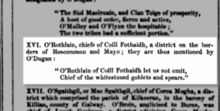Ó Rothláin

Ó Rothláin (/oʊ ˈroʊlɔːn/ oh-ROW-lawn) is an Irish name meaning "descendant of Rothlán". It is the pre-anglicised, Irish form of the names Rowlan, Rowland, Rowlands, Rollan, Rollin, Rolan and Rowley.[1] The name can also be found spelled as Ó Rothlán, Ó Rothlain, O'Rothlain, Rothlán, and Rothlan.[2][3][4]
History

The name Ó Rothláin is an Irish surname. It is strongly linked with County Mayo, Connacht.[5] According to Irish History the family were chieftains within Co. Mayo (titled as "Taoiseach").[6][7][8]
Genealogical Records
Ó Rothláin is recorded in The Tribes, Customs and Genealogies of the Hy Fiachrach by John O'Donovan.[9]
The earliest reference is found in Irish Annals dating back to 1208. According to the Annals of the Four Masters, Auliffe O'Rothlain, Chief of Calry of Coolcarney, was slain by O'Moran.[10] The next major mention of the name Ó Rothláin appears in the year 1337 in the Annals of Connacht (Annála Connacht),1337.9, stating that, "Master Ó Rothlain rested in Christ."[11] This same event again appears in the Annals of the Four Masters, M1337.3, "The Master Professor Ó Rothlain died."[12]
-

Coat of arms of Castlebar (Irish: Armas de Chaisleán an Bharraigh)
-
Croagh Patrick (Irish: Cruach Phádraig), Co. Mayo, Ireland
-

Castlebar, Co. Mayo, Connacht, Republic of Ireland.
Ulster Theory
The family may have been exiled or fled from Ulster for being Catholic in connection with the 1795 Battle of the Diamond.[13] Approximately 4,000 Ulster Catholics fled into County Mayo (see Crossmolina) after their defeat. This theory states that the family settled in and around the town of Castlebar where they can still be found bearing the name of Rowland. However, while some Ulster Catholics may have married into the family or clan, this theory is doubted as the families presence in Connacht pre-date 1795 by nearly 600 years.[14]
See also
- 1208 in Ireland
- 1337 in Ireland
- Kingdoms of Ancient Ireland
- Provinces of Ireland
- Annals of the Four Masters
- Uí Fiachrach Aidhne
- History of Ireland
References
- ↑ "Flann O'Riain", Townlands of Leinster and the people who lived there, Open Air, 2000, retrieved 2 February 2011
- ↑ Publications. 1844. pp. 171–.
- ↑ Irish Pedigrees: Or, The Origin and Stem of the Irish Nation. J. Duffy and Company. 1892. pp. 571–.
- ↑ Donahoe's Magazine. T.B. Noonan. 1880-01-01.
- ↑ The Irish Archaeological Society. A chorographical description of West or H-Iar Connaught, written A.D. 1684. (https://books.google.com/books?id=ywIGAAAAQAAJ&pg=PA145&dq=o%27rothlain&ei=DNo6S6eyFZDYNoTd6aMB&cd=8#v=onepage&q=o%27rothlain&f=false)
- ↑ O'Clery, Michael (1845-01-01). The annals of Ireland, tr. from the orig. Irish of the Four masters by O. Connellan.
- ↑ Knox, Hubert Thomas (1908-01-01). The history of the county of Mayo to the close of the sixteenth century. Judges. Figgis & Co., Ltd.
- ↑ Skene, William Forbes (1880-01-01). Celtic Scotland: A History of Ancient Alban. Edmonston & Douglas.
- ↑ O'Donovan, John (1993-06-01). Genealogies, Tribes & Customs of Hy-Fiachrach: Commonly Called O'Dowda's Country. Irish Roots Cafe. ISBN 9780940134386.
- ↑ Annals of the Four Masters. M1208.10. (http://www.ucc.ie/celt/published/T100005C/index.html)
- ↑ Annála Connacht. (http://www.ucc.ie/celt/published/T100011/)
- ↑ Annals of the Four Masters. M1337.3 (http://www.ucc.ie/celt/published/T100005C/index.html)
- ↑ Lecky, William Edward Hartpole (1898-01-01). A History of Ireland in the Eighteenth Century. Longmans, Green.
- ↑ Annals of the Four Masters. M1208.10. (http://www.ucc.ie/celt/published/T100005C/index.htm
External links
- Annals of the Four Masters from NewAdvent.org
- Surnames from AskOxford.com
- Tribes & Customs of Hy Fiachrach from the Irish Genealogical Foundation
- The Annals of the Four Masters (see Annal M1208.10, and M1337.3)
- Annála Connacht (see Annal 1337.9)